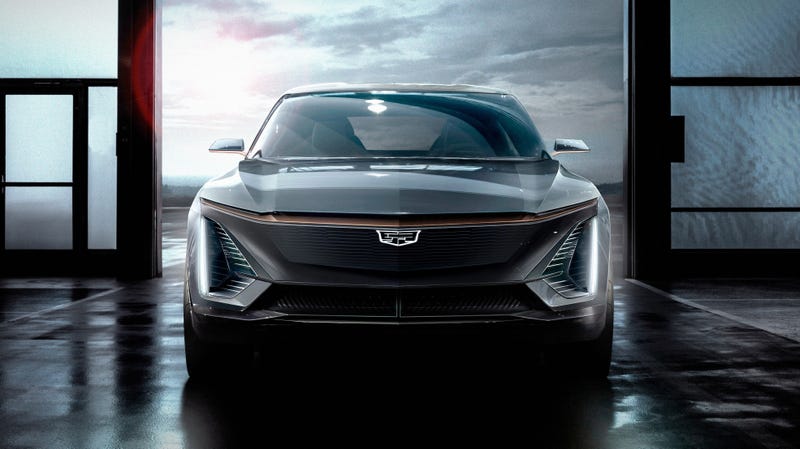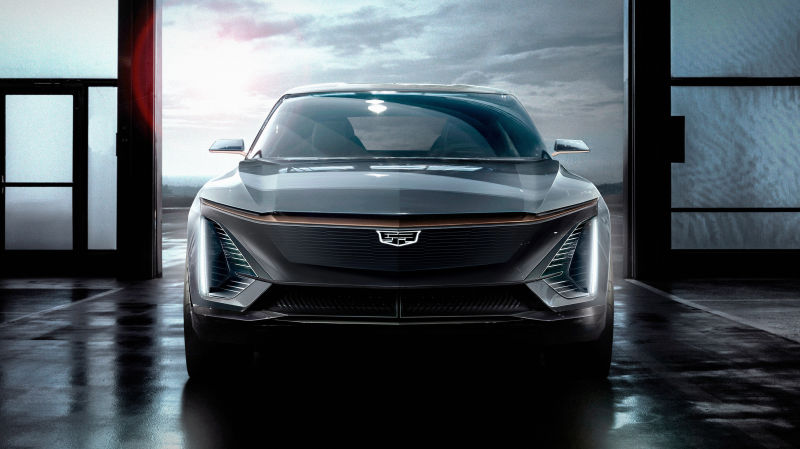
With an ongoing SUV boom killing sedan sales and an uncertain future around autonomy and electrification, the American automakers are having a strange time. And of all of them, Cadillac is perhaps the most perplexing. It’s gone through enough rebranding and transitions to give us whiplash. The latest moves include finally—finally—adding some money-making crossovers and SUVs to the lineup and also eventually pivoting to EVs, a move announced earlier this week. Will this be the time Cadillac eventually gets its shit together?
I sat down with Cadillac’s new boss, longtime GM executive Steve Carlisle, at the 2019 Detroit Auto Show to find out what he has in store for the future of the 117-year-old luxury division.
But from where I’m sitting, the details surrounding this attempt at a Cadillac comeback are vague at best and totally unclear at worst, with much of it hinging around the strength of “the brand.” But does that “brand” still have the power that people inside GM think it does, and what does that brand mean now after so many years were spent in New York City trying to define it better?
The XT6
Aside from promises of an EV, the most important Cadillac launch in Detroit was the Cadillac XT6, the division’s first, big three-row people-mover that isn’t the Escalade. It’s meant to be the solution to Cadillac’s woes—the division has lagged behind competitors in sales for being so sedan-heavy, and now it needs crossovers to compensate.
Advertisement
Carlisle’s tenure at GM spans a staggering 37 years. He’s worked in product planning, U.S. sales planning, global product planning and before becoming president of Cadillac, he was the president of GM Canada. It would be very fair to say that Carlisle knows General Motors and has seen its ups and downs.
Yet the XT6’s anodyne looks are a far cry from the drama of cars like the old CTS, or even the CT6. Plus, one criticism levied at the new XT6 is that it is basically just a rebadged Chevrolet, riding on the same platform as the Chevy Traverse and the Buick Enclave. What has Cadillac done to make more than just another expensive version of the same thing?
Advertisement
Carlisle attempted to explain it, albeit in very vague terms. “There’s a lot of Cadillac in the XT6,” he said. “The trims, styling and technology package are different; there are 20 safety and technology-related features. The packaging is different—we made adjustments in terms of spaciousness and third-row access. It’s a Cadillac.”
He didn’t add anything else, but a spokesperson sitting in on the interview chimed in to say that they’re counting on the strength of “the brand” here as well.
Advertisement
And there’s a lot more to come. Cadillac plans on launching one new car every six months for the next three years, which is not only incredibly ambitious, but also needed to replace a few aging products.
Yet the XT6 noticeably doesn’t come with Super Cruise, GM’s semi-autonomous tech. In fact, no Cadillac offers Super Cruise except for the CT6 since GM launched it in 2017.
The reason for this, mysteriously, is that Cadillac isn’t “ready” to put the technology in every car just yet, Carlisle said.
Advertisement
“If you think about where we are with our rollout cadence,” he said, “we have to consider, ‘Do we put Super Cruise in a product that’s getting close to the end of its life or do we put it in at the beginning of its life?’ This strategy reflects putting it in at the beginning of its life—not necessarily right at launch. We also want to consider the readiness of the technology.”
This struck me as odd because it doesn’t seem like it would be hard to outfit a car with the appropriate Super Cruise hardware and software, especially since it works quite well on the CT6. Cadillac launched the XT4 last year and it didn’t come with Super Cruise, either. And it’s the discrepancy between “the beginning of its life” but not “right at launch” is also a bit mystifying.
Advertisement
Nissan, on the other hand, announced that it would already begin to offer its ProPilot Assist system on the affordable Rogue and Altima models—cars that are accessible to most people.
A possible reason for this could be that Cadillac purposely launched Super Cruise on a car it knew would sell in lower volumes. The XT4 and XT6 are meant to be volume-sellers, so offering it to the masses could be problematic because customers might not be necessarily ready or fully knowledgable enough to be responsible for it. Tesla has certainly run into problems with this—widely putting that tech in the hands of a public not yet used to it is the recipe for idiots misusing Autopilot on YouTube.
Advertisement
Carlisle also assured me that sedans were definitely not going away; they are in the plans – and that includes the V-Series, so we have those to look forward to.
Electric Vehicles
Details on the upcoming Cadillac electric crossover we were shown are still vague, however. Carlisle wouldn’t comment on a name or manufacturing details, so we don’t yet know who the battery supplier is. But he likened its modular platform to Volkswagen’s MEB and confirmed that the flexible layout means that it will underpin a whole line of new Cadillac EVs.
Advertisement
In fact, he confirmed that eventually all Cadillacs will be EVs, because he believes the whole industry will go that way.
“GM will be all-electric at some stage,” he said. But that’s still a ways away, as there will be a “fairly long transition period.” But it doesn’t mean that Cadillac will be GM’s exclusive EV nameplate; other electric vehicles, both present and future and from other divisions, will continue on.
Advertisement
By going electric, Cadillac will most likely compete with Tesla’s clientele by selling stylish and up-market electric cars. I asked how Cadillac planned to differentiate itself from Tesla, as Tesla is the current go-to when people want a luxury EV.
“We’ll have a different portfolio, different technology play,” said Carlisle. “It’s the basis of competition.” He didn’t specify what that meant, however.
Advertisement
“It’ll have the look, the feel, the brand of Cadillac,” the spokesperson offered quickly. Neither offered anything more specific or nuanced than that.
All this “brand” talk was starting to sound suspiciously like the same rah-rah brand! spiel that Cadillac first pumped out when it moved to New York City in 2015. “Dare Greatly,” and all that. You know what happened there: After three short years of attempted re-branding and poor sales figures to show for it, GM decided to haul it back to Michigan.
Advertisement
Cadillac’s sales already trail behind its luxury competitors like Audi, Mercedes, BMW and Lexus. The president’s blandly lukewarm answer admittedly did not help convince me that Cadillac has a plan to go toe-to-toe against Tesla, which despite its flaws and issues has actually succeeded in stealing market share from the Germans—unlike GM.
Who’s almost guaranteed to buy these electric Cadillacs? China, probably. Which is why Cadillac is still betting big on China. Cadillac’s strong presence in China, in addition to the nation’s aggressive EV push, will make for a very, very valuable market. Carlisle confirmed the future EVs will be produced there in order for their prices to stay competitive with the Chinese-built EVs.
Advertisement
“Generally,” he said, “you follow a policy of building where you sell, including especially in China.”
But here in the U.S., the biggest hurdles that Cadillac faces in successfully selling EVs are similar to the ones that all manufacturers face. It comes down to range, education and experience, he said.
Carlisle said he believes that a high range offering opens the car up to the interest of more people, so that’s why the upcoming Cadillac EV crossover will have a projected “300-plus mile” range. And he said that Cadillac customers will have access to 10,000 charging points in the U.S., but didn’t specify where in the country those points would be, or how many of those would be vital fast-charging stations.
Advertisement
On the dealership side of things, salespeople need to be properly educated on the ins and outs of EVs. It’s been reported numeroustimesbefore that most dealers are either unwilling or bad at selling EVs to their customers, and for Cadillac’s pivot to truly take off, the dealer network will play a huge part. There are plans for Cadillac to roll out some dealership education programs, as well as bringing on some third-party groups that can also promote EV adoption through education, Carlisle promised.
But here Cadillac is behind the curve, again.Audi announced the E-Tron SUV all the way back in 2016. Same with Mercedes EQ concept. The Porsche Taycan is coming out this year. But two nights ago, in January 2019, we got a nameless sketch from Cadillac.
Advertisement
It’s gone this way before, this delay. It happened with offering “modern luxury.” It happened with sedans aimed at the Ms and AMGs of the world, only to come too late. It happened with the crossover and SUV onslaught and it seems like it’s happening again with offering an EV crossover.
When can we expect the see the first production Cadillac EV? According to Carlisle, “2021-ish.”
Why so late?
“The big question,” began Carlisle, “is how do we time ourselves to the market for this adoption cycle? When is the environment going to be right for the adoption of electric vehicles? I think that’s a very debatable point. We feel that we are timing this appropriately.”
Advertisement
“Also our product is distinctly Cadillac and people will buy into that brand and that substance,” added the spokesperson.
“Does that mean you believe people are… holding out for the Cadillac EV?” I asked.
“Are they holding out or are they just not ready?” Carlisle countered rhetorically.
Advertisement
It’s a tough question because it’s hard to define the “readiness” of consumers. But people bought expensive, luxury Teslas back in 2012 not because they were hurting from paying for gas, but because they wanted a sleek, new and high-tech vehicle to play with. With this in mind, it sounds to me like Cadillac is feeling out the market still, even though it has been seven years since luxury buyers showed themselves “ready” for a luxury-brand electric car.
That very well might be the way to play it safe in the short term. But while Cadillac is waiting for the public to be “ready,” buyers who are already “ready” are going ahead and buying the Teslas and the upcoming German EVs and forging new ties there.
Products speak for themselves, so I cannot wait to see how the electric Cadillacs are. I just wish they’d come sooner.
Advertisement
I have always been a fan of Cadillac. I appreciated its underdog status and how it offered up an American alternative to German and Japanese luxury, despite being late to many things.
But given the move to Detroit, an XT6 that didn’t exactly wow audiences and journalists at this auto show, a seemingly last-minute play for EVs and no clear answers on strategy, Cadillac has a lot of convincing to do that it can really become a high-performing global luxury nameplate this time around—and that it isn’t still just cruising on momentum from 50 years ago that fewer and fewer buyers even remember.













